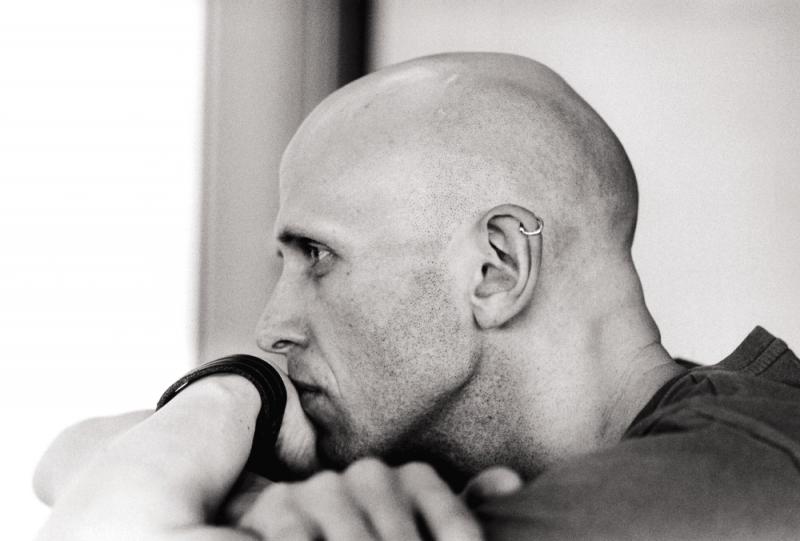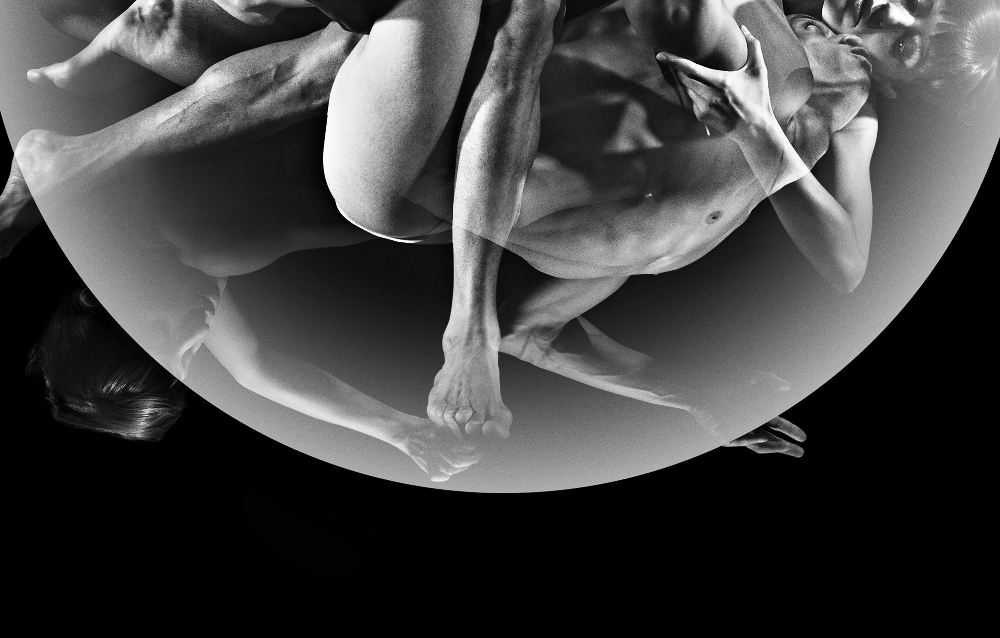Atomos, Wayne McGregor|Random Dance, Sadler's Wells Theatre | reviews, news & interviews
Atomos, Wayne McGregor|Random Dance, Sadler's Wells Theatre
Atomos, Wayne McGregor|Random Dance, Sadler's Wells Theatre
Swathes of talk a befuddling distraction from breathtakingly excellent dancing

Some choreographers get turned on by stories; others by music; yet others by the unpredictable magic of rehearsal room chemistry between dancers. Wayne McGregor, the shaven-headed, lanky, black clad superstar of British contemporary ballet, apparently needs a few research scientists, and a question philosophers have been trying to answer for three thousand years: what is a body?
This is the question heading up the programme notes for Atomos, the new piece by McGregor and Random Dance which had its world premiere at Sadler’s Wells last night. Helping McGregor and his dancers to answer it were live, digitally-manipulated music by A Winged Victory for the Sullen, lighting design by longtime McGregor collaborator Lucy Carter, and costumes that had been 3D printed (not that I could tell from looking at them) by Studio XO, self-declared “pioneers in ‘the internet of everything’ for the body”.
The palette of 'Atomos' is that of 1950s science-fiction - mauve, sand, burgundy, black and fluorescent green
First, let me say, each to their own; I’m genuinely pleased for McGregor that his high profile and commercial success enable him to work exactly the way he wants to with Random Dance. I admire him, too, for his restless need to question his own practices, and for the dedication with which he pursues collaborations with cognitive scientists, develops computer aids to choreography (what was previously the Choreographic Thinking Tool now seems to be a 3D “interactive digital object” which looks like a robot but moves like a human), and constantly imagines new ways to transform moments of inspiration into dance.
And yet, if you watch Atomos with its framing inquiry in mind – if you seek out interviews with McGregor, visit the exhibition, or read the programme notes – you will not be any closer to answering the original question, what is a body? Nor – crucially – will you enjoy the production any more than if you came at it quite uninformed. The wrapping of talk that McGregor’s creations come swathed in is (much like the 3D glasses given to audience members at the beginning of Atomos) a befuddling and unnecessary distraction from what is truly, breathtakingly, excellent: the dancing.
The ten dancers who make up Random Dance are by all measures superb – you won’t see better outside a major national company. For the seventy-five minutes of Atomos they are on stage almost constantly, and their bodies are bent, stretched, twisted, inverted and spun around by choreography that demands relentless energy and focus. McGregor’s instantly recognisable choreographic language combines the free movement grammar of contemporary dance with the sinuous grace and long extensions of ballet – a particularly exhausting combination for dancers to nail because it requires total fluidity and total control, as well as the ability to do things wrong while still looking right.

McGregor loves to bring his dancers out of turns in a counter-intuitive direction or to shatter and reassemble classical movement sequences. A striking example in Atomos is a pas de deux set over a cello solo. The situation is classical, but the movement cannot stay that way – arms are held up in fifth, then dive to the floor, while a developpé à la seconde is interrupted by a partner coming from behind at the most un-balletic waist level.
Random's dancers rise to such challenges with ease, but finding the emotional resonance to match this technical mastery proves a little trickier. Real human encounters, snapshots of tenderness or sadness or friendship between two or three dancers, are good, but disappointingly brief, in Atomos, flickering across the stage like the abstract, pixellated images displayed on seven screens above the dancers’ heads. We had better luck with group scenes: from the opening tableau of all ten dancers softly undulating in a pool of light, like seaweed rippling in clear water, every appearance of the whole company on stage was marked by increased energy, warmth and purpose.
The impression it left was unfortunately a little atomized
In part I think that is because the visual design feels most complete when all the dancers are present. The palette of Atomos is that of 1950s science-fiction – mauve, sand, burgundy, black and fluorescent green – and it is represented only partially on each dancer’s costume; only when all are on stage do the elements cohere into a whole, with the seemingly random undulating lines on each leotard setting up a visual resonance between the dancers that made them far more intelligible as a group than as discrete individuals.
At several points in Atomos, the music sounds like the low, amplified ringing of bronze bells, and in a way that summed up the whole experience for me: a sensually powerful reverberation that nevertheless quickly dies away. When you are inside it, Atomos is an immersive sensory experience, but no amount of technology or visual harmony can make up for the lack of a unifying emotional arc. McGregor’s quest to take apart every small impulse or inspiration that goes into creating a dance work may lead to interesting collaborations, and to a more cerebrally gratifying experience for dancers and choreographer, but the impression it left was unfortunately – and perhaps predictably – a little atomized.
Watch Wayne McGregor talking about the choreographic processes behind Atomos
rating
Explore topics
Share this article
Add comment
The future of Arts Journalism
You can stop theartsdesk.com closing!
We urgently need financing to survive. Our fundraising drive has thus far raised £49,000 but we need to reach £100,000 or we will be forced to close. Please contribute here: https://gofund.me/c3f6033d
And if you can forward this information to anyone who might assist, we’d be grateful.

Subscribe to theartsdesk.com
Thank you for continuing to read our work on theartsdesk.com. For unlimited access to every article in its entirety, including our archive of more than 15,000 pieces, we're asking for £5 per month or £40 per year. We feel it's a very good deal, and hope you do too.
To take a subscription now simply click here.
And if you're looking for that extra gift for a friend or family member, why not treat them to a theartsdesk.com gift subscription?
more Dance
 'We are bowled over!' Thank you for your messages of love and support
Much-appreciated words of commendation from readers and the cultural community
'We are bowled over!' Thank you for your messages of love and support
Much-appreciated words of commendation from readers and the cultural community
 iD-Reloaded, Cirque Éloize, Marlowe Theatre, Canterbury review - attitude, energy and invention
A riotous blend of urban dance music, hip hop and contemporary circus
iD-Reloaded, Cirque Éloize, Marlowe Theatre, Canterbury review - attitude, energy and invention
A riotous blend of urban dance music, hip hop and contemporary circus
 How to be a Dancer in 72,000 Easy Lessons, Teaċ Daṁsa review - a riveting account of a life in dance
Michael Keegan-Dolan's unique hybrid of physical theatre and comic monologue
How to be a Dancer in 72,000 Easy Lessons, Teaċ Daṁsa review - a riveting account of a life in dance
Michael Keegan-Dolan's unique hybrid of physical theatre and comic monologue
 A Single Man, Linbury Theatre review - an anatomy of melancholy, with breaks in the clouds
Ed Watson and Jonathan Goddard are extraordinary in Jonathan Watkins' dance theatre adaptation of Isherwood's novel
A Single Man, Linbury Theatre review - an anatomy of melancholy, with breaks in the clouds
Ed Watson and Jonathan Goddard are extraordinary in Jonathan Watkins' dance theatre adaptation of Isherwood's novel
 Peaky Blinders: The Redemption of Thomas Shelby, Rambert, Sadler's Wells review - exciting dancing, if you can see it
Six TV series reduced to 100 minutes' dance time doesn't quite compute
Peaky Blinders: The Redemption of Thomas Shelby, Rambert, Sadler's Wells review - exciting dancing, if you can see it
Six TV series reduced to 100 minutes' dance time doesn't quite compute
 Giselle, National Ballet of Japan review - return of a classic, refreshed and impeccably danced
First visit by Miyako Yoshida's company leaves you wanting more
Giselle, National Ballet of Japan review - return of a classic, refreshed and impeccably danced
First visit by Miyako Yoshida's company leaves you wanting more
 Quadrophenia, Sadler's Wells review - missed opportunity to give new stage life to a Who classic
The brilliant cast need a tighter score and a stronger narrative
Quadrophenia, Sadler's Wells review - missed opportunity to give new stage life to a Who classic
The brilliant cast need a tighter score and a stronger narrative
 The Midnight Bell, Sadler's Wells review - a first reprise for one of Matthew Bourne's most compelling shows to date
The after-hours lives of the sad and lonely are drawn with compassion, originality and skill
The Midnight Bell, Sadler's Wells review - a first reprise for one of Matthew Bourne's most compelling shows to date
The after-hours lives of the sad and lonely are drawn with compassion, originality and skill
 Ballet to Broadway: Wheeldon Works, Royal Ballet review - the impressive range and reach of Christopher Wheeldon's craft
The title says it: as dancemaker, as creative magnet, the man clearly works his socks off
Ballet to Broadway: Wheeldon Works, Royal Ballet review - the impressive range and reach of Christopher Wheeldon's craft
The title says it: as dancemaker, as creative magnet, the man clearly works his socks off
 The Forsythe Programme, English National Ballet review - brains, beauty and bravura
Once again the veteran choreographer and maverick William Forsythe raises ENB's game
The Forsythe Programme, English National Ballet review - brains, beauty and bravura
Once again the veteran choreographer and maverick William Forsythe raises ENB's game
 Sad Book, Hackney Empire review - What we feel, what we show, and the many ways we deal with sadness
A book about navigating grief feeds into unusual and compelling dance theatre
Sad Book, Hackney Empire review - What we feel, what we show, and the many ways we deal with sadness
A book about navigating grief feeds into unusual and compelling dance theatre
 Balanchine: Three Signature Works, Royal Ballet review - exuberant, joyful, exhilarating
A triumphant triple bill
Balanchine: Three Signature Works, Royal Ballet review - exuberant, joyful, exhilarating
A triumphant triple bill

Comments
Your appeasing comments are
Have to agree the 3D and